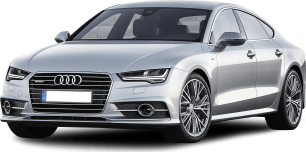There are three models in the range, and considering the most natural competitors to the Audi A7 - the Mercedes-Benz CLS (from $136,900) and the BMW 6 series GT (from $123,500) - there's an argument that this car is something of a bargain. Ahem. 'Bargain' is relative, clearly.
The entry-level model is the 45 TFSI, which lists at $113,900 plus on-road costs. That's pretty close to the existing starting point for the A7, but now there's a bit more gear included as standard. It doesn't arrive until around the middle of 2019, though.
This model is comprehensively kitted out, with standard inclusions consisting of 20-inch alloy wheels, adaptive suspension, Audi's 'progressive steering' system, LED headlights with high-beam assist, an electronic tailgate with smart opening, keyless entry and push-button start, 'Valcona' leather trim and sports front seats, electric front seat adjustment and front seat heating and three-zone climate control air conditioning.
Other goodies include an LED interior ambient lighting package, head-up display, Audi's 12.3-inch 'Virtual Cockpit' digital driver information display, a 10.1-inch media screen and 8.6-inch control touchscreen, Bluetooth phone and audio streaming, USB connectivity, Apple CarPlay and Android Auto phone mirroring, and wireless smartphone charging.
Next up the model range is the 55 TFSI, which has a list price of $131,900 before on-road costs - which is the exact same price, and carries the exact same level of standard specification, as the diesel-powered 50 TDI model (also due mid-2019). This splits the difference between the existing models, but still undercuts the rivals by a good margin.
Over the entry-grade model, the 50 TDI and 55 TFSI models bring matrix LED headlights (with light animation), a different 20-inch wheel design, the S line exterior styling pack - essentially a body kit with new front and rear bumpers incorporating mesh-look diffusers and new side sills, plus S line badging.
These two models also get different interior styling, too, with S line embossed leather seats, illuminated door sill trims, a flat-bottom leather wheel with paddle shifters, dark brushed aluminium inlays, stainless steel faced pedals, black headlining, piped floor mats, electric steering column adjustment and a Bang & Olufsen 3D 705-watt sound system with 16 speakers and subwoofer.
There's a lot of safety kit included at each price point, too - see the section below for a breakdown.
Audi has tried to simplify things in terms of optional gear - apparently its customers said there was too much complexity when it came to electing bits and bobs, so the company's local arm has just one optional package... and a few other items it says are very much "buyer specific".
The 'Premium Plus' package costs $6500 for the 45 TFSI and $8000 for the other two models (and you get air suspension included in those grades). Across all grades the pack adds 21-inch alloy wheels, tinted rear glass, a panoramic glass roof, an extended upholstery package, four-zone climate control with rear touch control panel, plus a colour interior lighting package with up to 30 colours.
Other options include metallic paint (up to $2200), a four-wheel steering system ($4200) and laser headlights ($2500).

